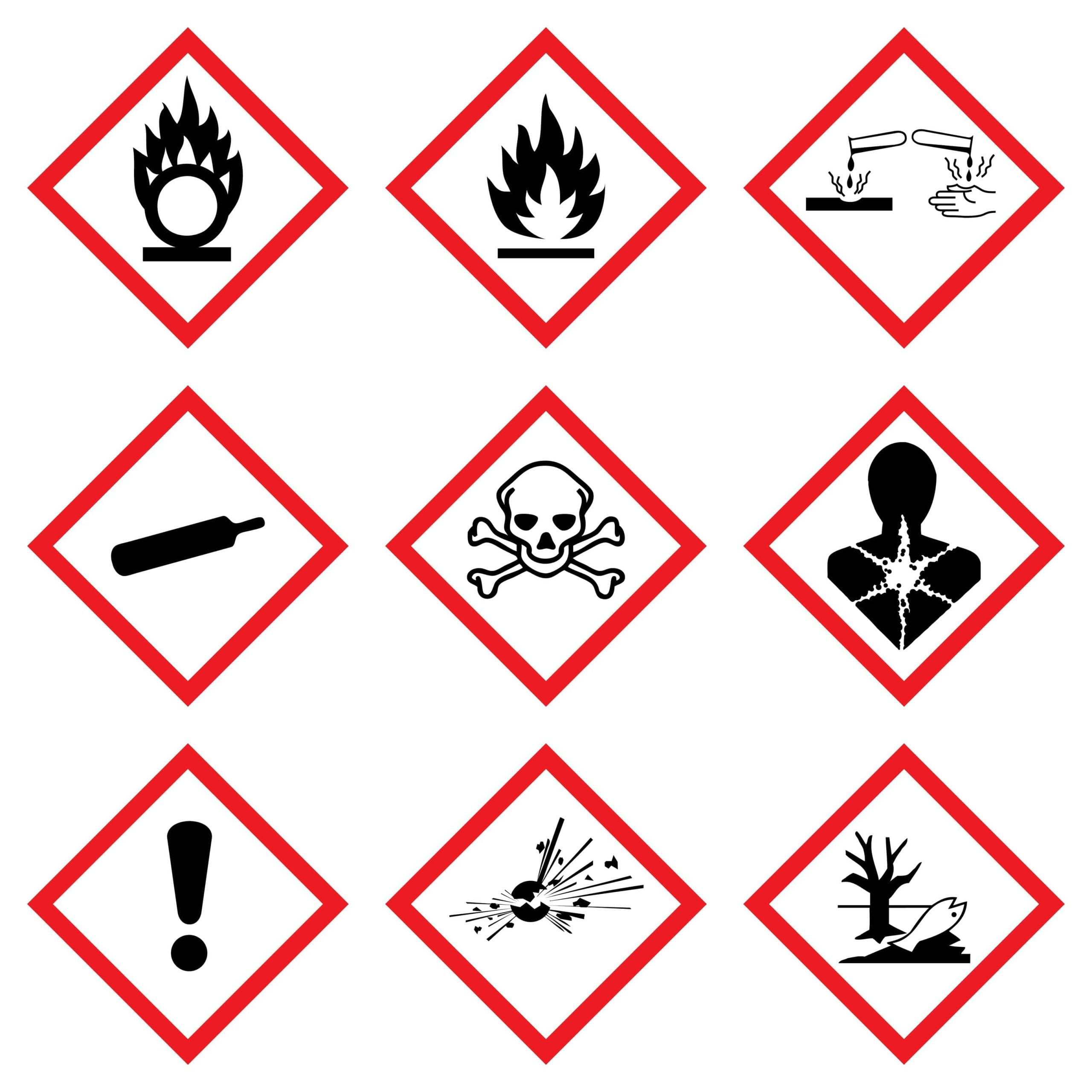GHS labels and pictograms of chemicals have a significant role in ensuring workplace safety. They guide workers in handling products properly, disposing chemicals appropriately, and storing them suitably. However, the GHS labels give people comprehensive knowledge about the possible hazards linked with the particular substance and enable them to take the necessary safeguards. In this guide, you will learn about GHS label requirements and other important factors related to these ultra-important symbols.
To start, GHS labels are used to make hazard communication standardized and simpler. However, in order to be effective, these labels must be readable, long-lasting, and clearly placed on the container. They must also be written in the language(s) specified by local regulations.
 What Are GHS Label Requirements?
What Are GHS Label Requirements?
So what are the substantial GHS label requirements? The GHS stands for the Globally Harmonized System of classifying and labeling chemicals. It is an internationally recognized system that is used to classify and label chemical warnings in a standardized way.
However, these labels are used on GHS secondary containers or hazardous chemicals to talk about the potential risks associated with chemicals. It helps workers, consumers, and emergency responders to understand the situation easily. The GHS label consists of six important pieces of information: name, address, product identifier, phone number of supplier, and signal word.
1. Product Identifier
This element provides information about the chemical or product being labeled. It usually includes the chemical name or a code that uniquely identifies the substance. This helps users identify the specific chemical they are dealing with.
2. Signal word
The signal word is used to convey the severity of the hazards that are associated with the chemical as quickly as possible. There are two signal words;
Danger: This sign usually indicates a higher level of hazards that imply more severe risks.
Warning: The warning sign indicates the lower level of hazards that shows fewer chances of risks.
3. Hazard Pictograms
GHS labels include standardized pictograms which represent different types of hazards associated with the chemical. These pictograms help professionals recognize symbols that provide a quick visual identification of chemical hazards. However, the number and type of pictograms on a label depend on the risk connected to the substance.
4. Hazard Statements
Hazard statements are also known as standardized phrases that explain the kind of risk associated with such a chemical or a substance. These signs provide more detailed information about the hazards that are accompanied by such substances including “flammable liquid” or “cause skin irritation.”
5. Manufacturer/Supplier information
GHS labels typically include information about the supplier or manufacturer of the chemical. This information may include the name, address, and contact details of the supplier, as well as an emergency telephone number for obtaining additional information or assistance.
6. Precautionary statement
Precautionary statements provide instructions on how to handle, store, and dispose of the chemical properly in order to reduce hazards. These statements educate users of safety precautions to take, such as wearing the proper personal protective equipment (PPE), as well as what to do in the event of exposure or accidents.
What Information Is Unnecessary On A Chemical Label?
When creating chemical warning labels, it is imperative to include all the necessary or accurate information. Make sure that every GHS label consists of relevant regulation that ensures the safe handling and use of the product. However, leaving out important details might put people in danger and non-compliance with legal requirements. There are things that are significant to consider for creating hazardous chemical labels.
 1. Excessive Market Information
1. Excessive Market Information
While it’s common for manufacturers and suppliers to include branding and marketing information on product labels, it should not overshadow or interfere with the presentation of essential safety information. The primary purpose of a chemical label is to communicate hazards and safety precautions. It means the hazardous chemical labels need to be simple, clear, and straightforward for better understanding.
2. Non-Hazard Related Graphics
Avoid using ornamental or unrelated-to-hazards pictures or images on GHS chemical labels, as they may distract from important safety information and do not add to your understanding of the chemical’s hazard. Your graphics for pictogram GHS labels need to be as simple as possible.
3. Established Label Requirements
Information should not be provided if it does not adhere to the rules and regulations that are relevant to chemical warning labels in the region or jurisdiction. To ensure compliance and clarity, adhere to the prescribed labeling criteria.
4. Gather Up-To-Date Information
Make sure that the GHS label always provides up-to-date, accurate, and comprehensive hazard information. Before adding any information, it is your responsibility to ensure that the label is free from outdated or inaccurate information. Adding such information could be potentially dangerous.
5. Avoid To Add False & Misleading Claims
It is crucial to not use such labels that contain any false and misleading claims about the chemical properties, safety, and effectiveness. Make sure that any claim on the GHS labels need to be accurate, true, or supported by evidence.
6. Do Not Use Unrelated Symbols
Symbols or icons that do not relate to safety, hazard communication, or product identification should not be included on the label. It is significant to use emblems of GHS pictogram labels that communicate any hazardous situation such as signs of fire, health hazards, compressed gas, etc.
7. Do Not Excessive Technical Jargon
Avoid overly use of technical language that may be difficult for the intended audience to understand. The language used on the chemical warning label should be clear and accessible to users. Using simple and clear language is the best way to create a sense of attentiveness among individuals.
Learn More About Hazardous Chemicals
It is important to learn more about the GHS and hazardous chemical labels to ensure the safety of the workplace and employees’ health. To obtain qualitative, comprehensive, and thought-provoking knowledge on GHS label requirements, it is the best time to sign up for OSHA training courses like OSHA 10-hour construction and OSHA 30-hour construction. OSHA safety training courses help to keep you up-to-date about modern and standardized hazard communication tips.



